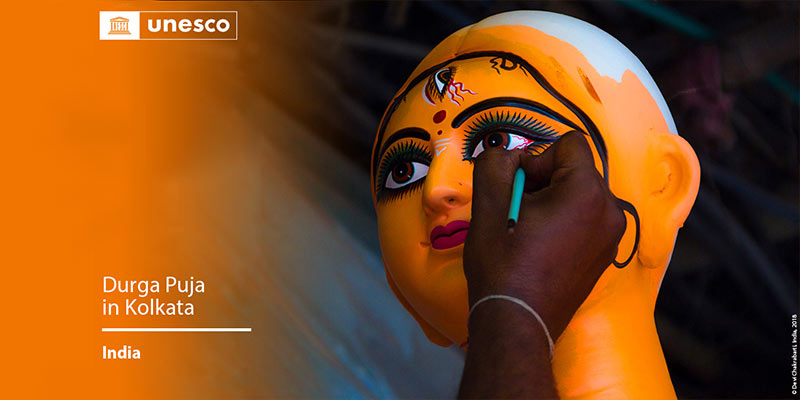- India
- Dec 16
UNESCO adds Durga Puja to Intangible Cultural Heritage List
• UNESCO added Durga Puja in Kolkata to the Representative List of the Intangible Cultural Heritage of Humanity.
• The decision was taken during the 16th Session of the Intergovernmental Committee for the Safeguarding of the Intangible Cultural Heritage.
• The Representative List of the Intangible Cultural Heritage of Humanity currently has 492 elements. It includes forms of expression that testify to the diversity of intangible heritage and raises awareness of its importance. By enhancing the visibility of communities’ cultural practices and know-how, UNESCO aims to safeguard the intangible cultural heritage of communities globally.
• India houses a repository of unique Intangible Cultural Heritage traditions, 14 of which have been recognised by UNESCO as Intangible Cultural Heritage of Humanity.
Significance of intangible cultural heritage
• The term ‘cultural heritage’ has changed content considerably in recent decades, partially owing to the instruments developed by UNESCO. Cultural heritage does not end at monuments and collections of objects. It also includes traditions or living expressions inherited from our ancestors and passed on to our descendants, such as oral traditions, performing arts, social practices, rituals, festive events, knowledge and practices concerning nature and the universe or the knowledge and skills to produce traditional crafts.
• While fragile, intangible cultural heritage is an important factor in maintaining cultural diversity in the face of growing globalisation. An understanding of the intangible cultural heritage of different communities helps with intercultural dialogue, and encourages mutual respect for other ways of life.
• The “intangible cultural heritage” means the practices, representations, expressions, knowledge, skills — as well as the instruments, objects, artefacts and cultural spaces associated therewith — that communities, groups and, in some cases, individuals recognise as part of their cultural heritage.
• This intangible cultural heritage, transmitted from generation to generation, is constantly recreated by communities and groups in response to their environment, their interaction with nature and their history, and provides them with a sense of identity and continuity, thus promoting respect for cultural diversity and human creativity.
• The importance of intangible cultural heritage is not the cultural manifestation itself, but rather the wealth of knowledge and skills that is transmitted through it from one generation to the next. The social and economic value of this transmission of knowledge is relevant for minority groups and for mainstream social groups within a country, and is as important for developing nations as for developed ones.
• Following UNESCO’s 2003 Convention for Safeguarding of Intangible Cultural Heritage, this list has been classified into five broad domains in which intangible cultural heritage is manifested:
1) Oral traditions and expressions, including language as a vehicle of the intangible cultural heritage.
2) Performing arts.
3) Social practices, rituals and festive events.
4) Knowledge and practices concerning nature and the universe.
5) Traditional craftsmanship.
Durga Puja
• While Durga Puja is one of the most important festivals of West Bengal, it is widely observed across the country and in major cities of the world by the Bengali diaspora. Over the years, Kolkata has emerged as the geographical and cultural heart of the national and global celebrations of the festival.
• Durga Puja is an annual festival celebrated in September or October. It marks the ten-day worship of the Hindu Goddess Durga.
• In the months preceding the festival, small artisanal workshops sculpt images of Durga and her family using unfired clay pulled from the Ganga River. The worship of the Goddess then begins on the inaugural day of Mahalaya, when eyes are painted onto the clay images to bring the Goddess to life.
• It ends on the tenth day, when the images are immersed in the river from where the clay came. Thus, the festival has also come to signify ‘homecoming’ or a seasonal return to one’s roots.
• Durga Puja is seen as the best instance of the public performance of religion and art, and as a thriving ground for collaborative artists and designers. The festival is characterised by large-scale installations and pavilions where communities get together and celebrate. Several folk music, culinary, craft, and performing arts traditions add to the dynamism of this celebration.
Other 13 elements of India in the List:
1) Tradition of Vedic chanting
2) Ramlila - the traditional performance of the Ramayana
3) Kutiyattam (Koodiyattam) - Sanskrit theatre
4) Ramman - religious festival and ritual theatre of the Garhwal Himalayas
5) Mudiyettu - ritual theatre and dance drama of Kerala
6) Kalbelia - folk songs and dances of Rajasthan
7) Chhau dance
8) Buddhist chanting of Ladakh - recitation of sacred Buddhist texts in the trans-Himalayan Ladakh region
9) Sankirtana - ritual singing, drumming and dancing of Manipur
10) Traditional brass and copper craft of utensil making among the Thatheras of Jandiala Guru, Punjab
11) Yoga
12) Nowruz
13) Kumbh Mela.
Manorama Yearbook app is now available on Google Play Store and iOS App Store

